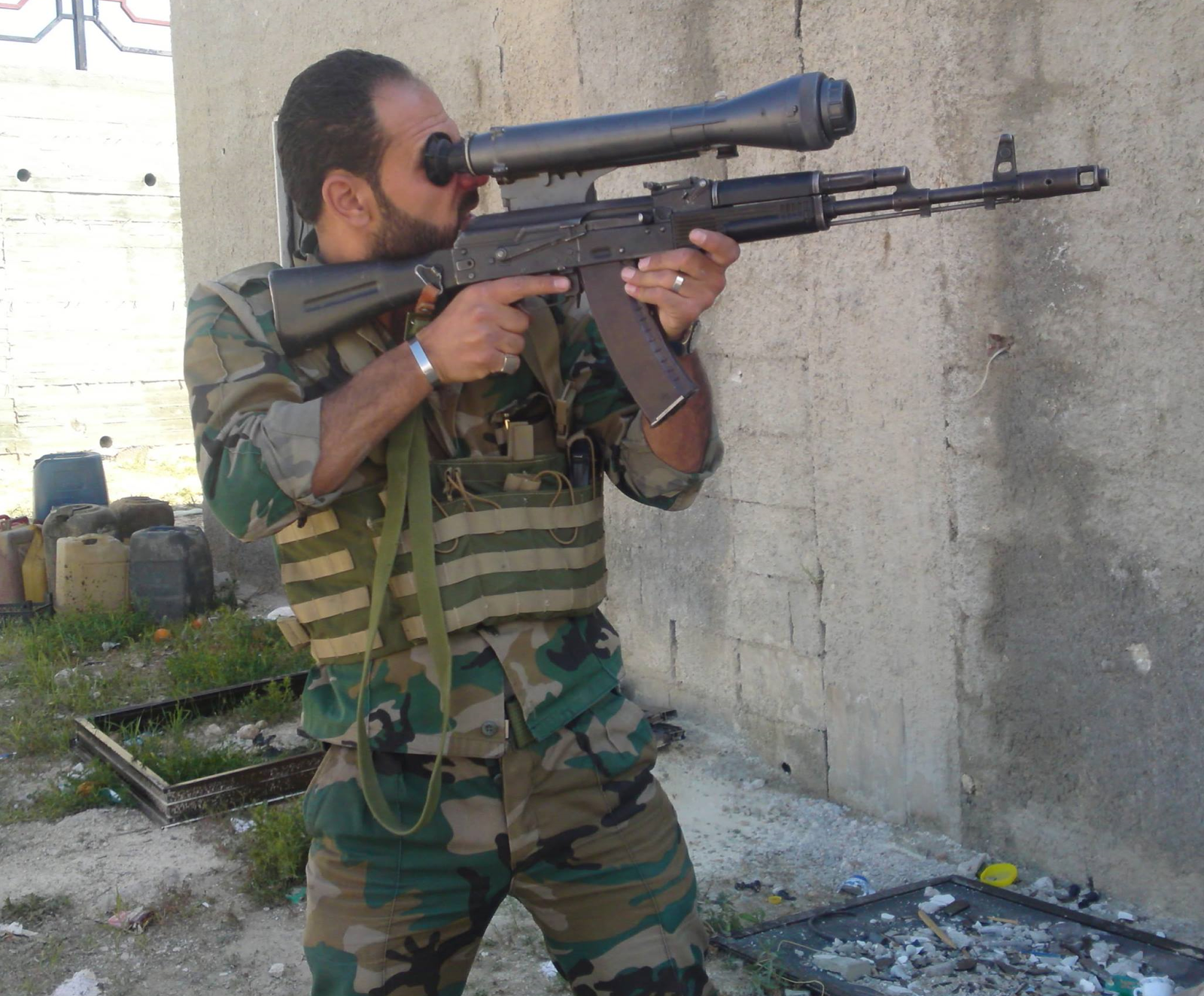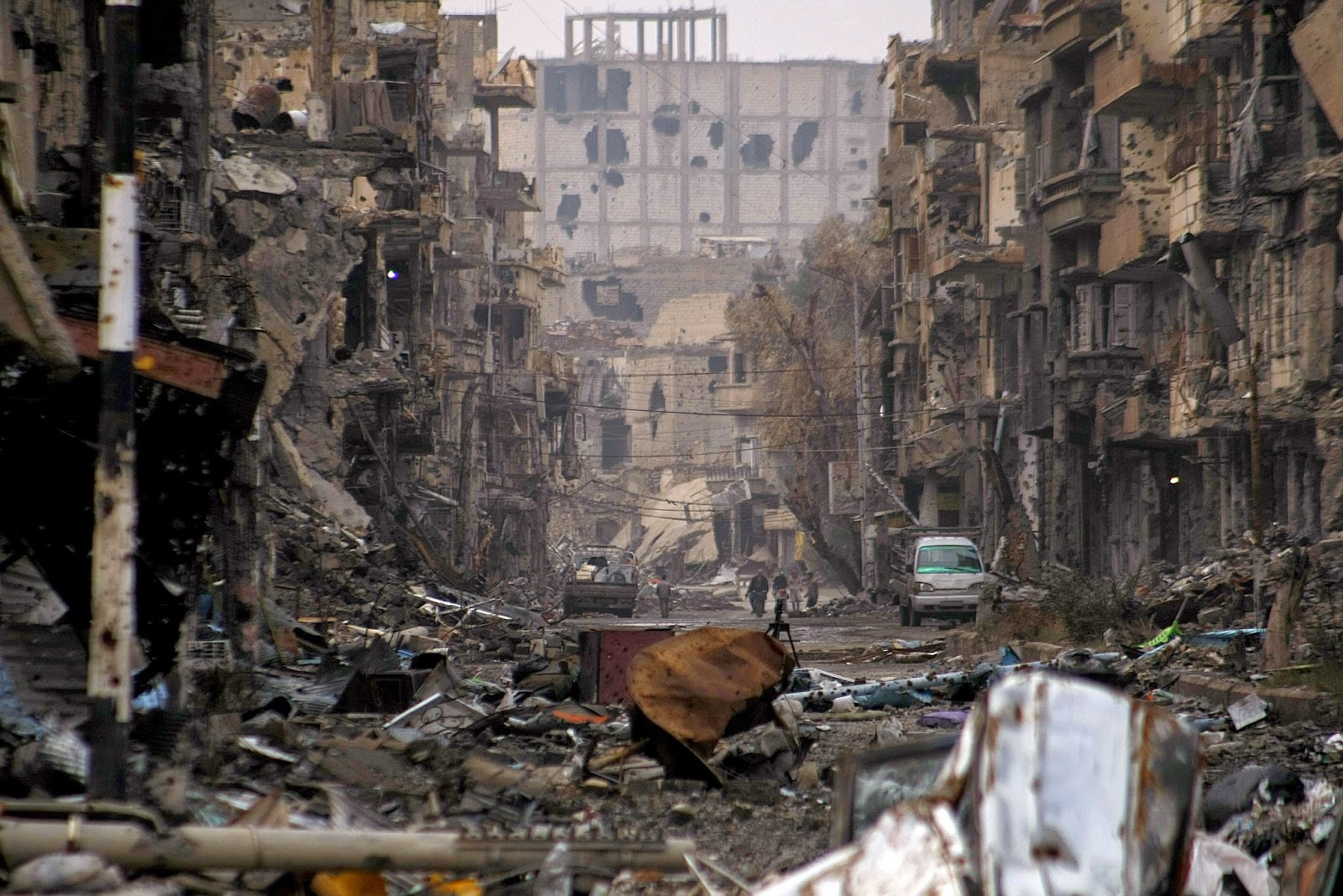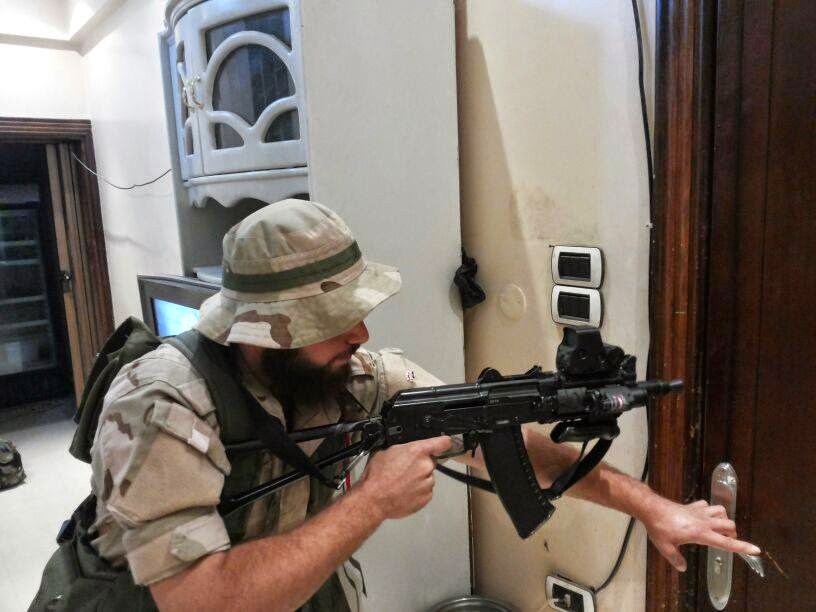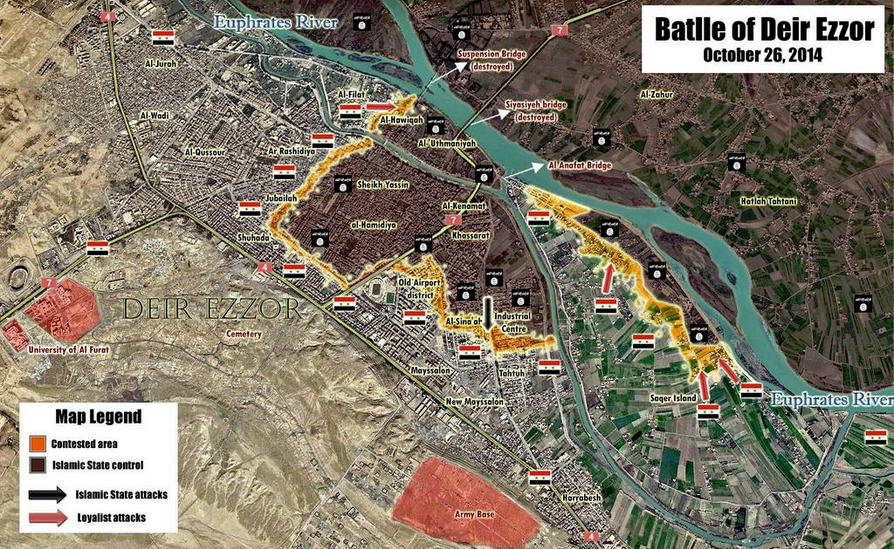Deir ez-Zor is perhaps Syria's most underreported city; while originally largely under Free Syrian Army control after the start of the civil war, the city was taken over by the Islamic State in early July, which subsequently faced a little-reported Republican Guard offensive aimed at encircling the city. In early December, the Islamic State made a push in the direction of Deir ez-Zor's airbase, a vital lifeline to the city.
Deir ez-Zor is perhaps best known for its oilfields, and previously much of the fighting around the city involved fighting for control over these strategically important objectives. As the oilfields used to provide much of the fuel for the Syrian Arab Army, the Republican Guard, the National Defence Force and Suqur al-Sahara (Desert Falcons), their takeover about a year ago was a serious blow to all forces loyal to Assad and endangered the fuel supply badly needed to mount new offensives. While Russian contractors belonging to the Slavonic Corpswere intially sent to protect these oilfields, they did not even manage to reach Deir ez-Zor.
The dwindling fuel supplies already forced the widespread introduction of tank trailers, as there simply isn't enough fuel for the tanks to drive to their deployment zone by themself. A situation that isn't going to improve unless the oilfields around Deir ez-Zor are recaptured.
A number of reasons explain why there's still a large Syrian military presence in Deir ez-Zor. Firstly, Deir ez-Zor was reinforced by elements of the Republican Guard's 104th Brigade led by Brigadier General Issam Zahreddine in early 2014. Secondly, the airbase is still in government hands; it has proven vital to quickly resupply the city and fighter-bombers stationed there also provide much of the air support to forces in and around the city. Thirdly, the Damascus - Palmyra - Deir ez-Zor highway remains under government control. This highway is used to ferry reinforcements and supplies to the city. Lastly, the high ground around the city remains in the hands of the Syrian Arab Army (SAA). The SAA positioned numerous howitzers, field guns and multiple rocket launchers (MRLs) here, which can fire at any target within the city and also cover the approaches to the airbase.
The Republican Guard's 104th Brigade was intially rushed to Aleppo to launch a new series of offensives in the hope of regaining some of the lost ground in and around Aleppo, but saw itself transferred to Deir ez-Zor in early 2014 to reinforce the remainder of the Syrian Arab Army garrison. It is unknown if the entire 104th or only a part of it was transferred to Deir ez-Zor. As the amount of Republican Guard fighters in Deir ez-Zor remains low, the latter seems more likely. The contingent currently deployed in Deir ez-Zor is led by Issam Zahreddine, a Druze and undoubtedly the most popular general found within Syria. The reason for his popularity is that he personally leads his soldiers into battle, can always be found on the frontline and shares the same priviliges as his soldiers, even if that means sitting in a BMP-1 driving towards the frontline.
The 104th is sometimes classified as the 104th Airborne Brigade of the Republican Guard, and while a few soldiers in the brigade were indeed trained as what one would call paratroopers, and others were learned how to deploy from low-flying helicopters, the 104th is believed to have been "airborne" only in name, displaying the characteristics of a mechanised brigade instead. The fact that Syrian military doctrine does not envisage airborne operations supports this theory.
Nonetheless, the contingent deployed to Deir ez-Zor only managed to acquire a limited amount of older T-72 Urals, T-72M1s, BMP-1s and some ZSU-23s from other units. A couple of Falaq-2 launchers are also operated. The 104th using T-72s in Deir ez-Zor marked the first deployment of this type in the city, as the 137th Mechanized Brigade had only been operating T-55s.
During the initial operations in Damascus, the 104th operated several TURMS-T equipped T-72s (Syria's most modern tanks) but all appear to have been transferred to another unit within the Republican Guard. While the brigade thus lacks large amounts of modern tanks, it did receive a sizeable batch of Sayyad-2 anti-materiel sniper rifles and AK-74Ms, Syria's most modern assault rifle.
Unsurprisingly, the 104th Brigade contingent boosts a significant amount of Druze fighters. Issam Zahreddine's bodyguard unit is also believed to consist mainly of Druzes. The need for bodyguards is a direct result of his popularity in Syria and more importantly, the $200,000 bountyon Zahreddine's head.
The 104th came to Deir ez-Zor with two important tasks: Securing the airbase by pushing back the fighters of the Islamic State and encircling them within the city centre so a new offensive on the oilfields could be initiated. The first goal was accomplished quite quickly after the 104th arrived. After Tabqa fell, Issam Zahreddine remarked: ''Deir ez-Zor airbase is not Tabqa airbase. We will bury IS here.''
Ground forces already operating in Deir ez-Zor were limited to 137th Mechanized Brigade, which already lost most of its fighting power and tanks during two years of heavy fighting, yet remained in control of parts of the city and the strategic hills. Along with NDF troops, made up of civilians, reservists and a few regular soldiers they were already busy with defending the remaining parts of the city and airbase, and did not have the power to launch an offensive themselves.
The 104th contingent deployed to Deir ez-Zor was also quite small, and was forced to carefully balance its troops in order to be able to fend off any assauls on its flanks during its own offensives. So while much of the 104th was mostly on the offensive, a part was distributed along the city permiter to reinforce the SAA and NDF soldiers already present here. The battles fought within the city centre were extremely fierce. Local offensives usually saw both sides fighting for housing blocks, during which neither sides could really advance. The Islamic State also made extensive use of tunnels, some of which were ultimatelydestroyed. The SAA and NDF could count on artillery support from the nearby hills, which subsequently destroyed most of the city and due to the close proximity of both sides, did also occasionally result in SAA casualties.[1] Footage of the fighting inside Deir ez-Zor can be seen here.
The underreported offensive was aimed at cutting off the city centre from Islamic State-held territory at the opposite side of the river. The 104th was split into two, with both parts attacking from a different direction.
As seen in the map, one part attacked from Al Filat while the other part crossed the river to Saqr (Saqer) Island. Contrary to the fighting in the city, the battle for Saqr Island was fought between thick layers of trees, bushes and crops. Footage from the Battle of Saqr Island in chronological order can be seen here and here.
During his operations, Issam Zahreddine used tactics the SAA and NDF could only dream off, especially in the early stages of the Syrian Civil War. T-72s moving up while followed by infantry and covered by other T-72s and ZSU-23s, the infantry clears the housing, again supported by T-72s and ZSU-23s and the process is repeated again and again. This in sharp contrast to the use of tanks in the early days of the Civil War, when they were used as battering rams charging through cities, often falling prey to RPG fire. One of the T-72M1s deployed to Deir ez-Zor can be seen below. The flag seen on the right belongs to the Druze community.
The ultimate goal of the Al Filat - Saqr Island offensive was to encircle the fighters of the Islamic State within Deir ez-Zor itself, after which the 104th could be used in a new offensive to regain the lost oilfields scattered around Deir ez-Zor. The fighting for the city would be left to the Syrian Arab Army, the National Defence Force and a new militia called the National Security.[2] Trained at the base of the 137th Mechanized Brigade, it would have consisted of people not yet fighting with the Syrian Arab Army or National Defence Force.
The downside of this offensive for the SAA, NDF and 104th was that it exposed the weak flanks even more. As the forces were already stretched thin here, it was just a matter of time before the Islamic State would attempt to benefit from this situation.
Although some suggest the push on the airbase is a direct result of the stalemate in Kobanî, which brought the need for another victory, this can be quickly dismissed as Kweres airbase would be better suited for a quick victory. Kweres, formerly the main training base of the Syrian Arab Air Force (SyAAF), has been under siege since December 2012 and is now nothing more than a runway littered with plane wrecks and troops only capable of defending the base.
Deir ez-Zor's airbase is home to the SyAAF's 8th Squadronoperating the MiG-21. Around a dozen decommissioned MiG-21s can be seen on satellite imagery, suggesting 8th Squadron received more MiG-21s from other Squadrons within Syria to stay operational. 8th Squadron also suffered several losses because of ATGM teams around the airbase, which destroyed at least two MiG-21s within their hardened aircraft shelters (HAS). This forced the SyAAF to hide most its planes behind raised sand covers.
![]()
Deir ez-Zor also sees regular deployments of Mi-8/17s, Mi-25s and even MiG-23BNs. Furthermore, the 104th can call upon the SyAAF's 819thSquadron, flying recently upgraded Su-24M2s, for precision attacks.[3][4] These aircraft have been frequently spotted over Deir ez-Zor.
Deir ez-Zor used to house four 2K12 SAM sites for the protection of the airbase and city. While one of these was destroyed by the Free Syrian Army while retreating to regime-held territory and another inactive site was overrun by the Islamic State (one of the inoperational captured launcher units can be seen below), two still remain under regime control. Of these two, only one remains partially operational.
The Damascus - Palmyra - Deir ez-Zor highway, which was used by the 104th to reach Deir ez-Zor, also remains under government control and has proven to be of vital importance as it is the city's second lifeline. Convoys still use this road to resupply the SAA, NDF and 104th as a cheaper alternative to the SyAAF's airbridge constructed by An-26s and Il-76s.
Holding on to this road, the strategic airbase and surrounding hills is of great importance for the SAA, NDF and 104th in and around Deir ez-Zor. Previously gained ground might have to be abandoned to free up forces for the defence of Deir ez-Zor's airbase. The SAA, NDF and 104th's ability to call in air support and artillery due to their control of the high ground might be just enough to ensure their presence in Deir ez-Zor is there to stay.
But as the magnitude of the Islamic State's offensive remains unknown, it is as of yet impossible to judge if they've embarked on a large scale offensive aimed at finishing the regime's presence in Deir ez-Zour once and for all, or if they're simply probing the defences of the SAA, NDF and 104th around the airbase, hoping to gain a direct line of sight of the runway via the neigbourhoods of Jaffra and Al-Mari’iyya, making it impossible for the SyAAF to take off. It is also possible the assault is a diversion for a future offensive aimed at retaking some of the ground it lost in the recent months, thus preventing possible encirclement.
Recommended Articles
Syria's Steel Beasts: The T-55
Syria's Steel Beasts: The T-62
Deir ez-Zor is perhaps best known for its oilfields, and previously much of the fighting around the city involved fighting for control over these strategically important objectives. As the oilfields used to provide much of the fuel for the Syrian Arab Army, the Republican Guard, the National Defence Force and Suqur al-Sahara (Desert Falcons), their takeover about a year ago was a serious blow to all forces loyal to Assad and endangered the fuel supply badly needed to mount new offensives. While Russian contractors belonging to the Slavonic Corpswere intially sent to protect these oilfields, they did not even manage to reach Deir ez-Zor.
The dwindling fuel supplies already forced the widespread introduction of tank trailers, as there simply isn't enough fuel for the tanks to drive to their deployment zone by themself. A situation that isn't going to improve unless the oilfields around Deir ez-Zor are recaptured.
A number of reasons explain why there's still a large Syrian military presence in Deir ez-Zor. Firstly, Deir ez-Zor was reinforced by elements of the Republican Guard's 104th Brigade led by Brigadier General Issam Zahreddine in early 2014. Secondly, the airbase is still in government hands; it has proven vital to quickly resupply the city and fighter-bombers stationed there also provide much of the air support to forces in and around the city. Thirdly, the Damascus - Palmyra - Deir ez-Zor highway remains under government control. This highway is used to ferry reinforcements and supplies to the city. Lastly, the high ground around the city remains in the hands of the Syrian Arab Army (SAA). The SAA positioned numerous howitzers, field guns and multiple rocket launchers (MRLs) here, which can fire at any target within the city and also cover the approaches to the airbase.
The Republican Guard's 104th Brigade was intially rushed to Aleppo to launch a new series of offensives in the hope of regaining some of the lost ground in and around Aleppo, but saw itself transferred to Deir ez-Zor in early 2014 to reinforce the remainder of the Syrian Arab Army garrison. It is unknown if the entire 104th or only a part of it was transferred to Deir ez-Zor. As the amount of Republican Guard fighters in Deir ez-Zor remains low, the latter seems more likely. The contingent currently deployed in Deir ez-Zor is led by Issam Zahreddine, a Druze and undoubtedly the most popular general found within Syria. The reason for his popularity is that he personally leads his soldiers into battle, can always be found on the frontline and shares the same priviliges as his soldiers, even if that means sitting in a BMP-1 driving towards the frontline.
The 104th is sometimes classified as the 104th Airborne Brigade of the Republican Guard, and while a few soldiers in the brigade were indeed trained as what one would call paratroopers, and others were learned how to deploy from low-flying helicopters, the 104th is believed to have been "airborne" only in name, displaying the characteristics of a mechanised brigade instead. The fact that Syrian military doctrine does not envisage airborne operations supports this theory.
Nonetheless, the contingent deployed to Deir ez-Zor only managed to acquire a limited amount of older T-72 Urals, T-72M1s, BMP-1s and some ZSU-23s from other units. A couple of Falaq-2 launchers are also operated. The 104th using T-72s in Deir ez-Zor marked the first deployment of this type in the city, as the 137th Mechanized Brigade had only been operating T-55s.
During the initial operations in Damascus, the 104th operated several TURMS-T equipped T-72s (Syria's most modern tanks) but all appear to have been transferred to another unit within the Republican Guard. While the brigade thus lacks large amounts of modern tanks, it did receive a sizeable batch of Sayyad-2 anti-materiel sniper rifles and AK-74Ms, Syria's most modern assault rifle.
Unsurprisingly, the 104th Brigade contingent boosts a significant amount of Druze fighters. Issam Zahreddine's bodyguard unit is also believed to consist mainly of Druzes. The need for bodyguards is a direct result of his popularity in Syria and more importantly, the $200,000 bountyon Zahreddine's head.
The 104th came to Deir ez-Zor with two important tasks: Securing the airbase by pushing back the fighters of the Islamic State and encircling them within the city centre so a new offensive on the oilfields could be initiated. The first goal was accomplished quite quickly after the 104th arrived. After Tabqa fell, Issam Zahreddine remarked: ''Deir ez-Zor airbase is not Tabqa airbase. We will bury IS here.''
Ground forces already operating in Deir ez-Zor were limited to 137th Mechanized Brigade, which already lost most of its fighting power and tanks during two years of heavy fighting, yet remained in control of parts of the city and the strategic hills. Along with NDF troops, made up of civilians, reservists and a few regular soldiers they were already busy with defending the remaining parts of the city and airbase, and did not have the power to launch an offensive themselves.
The 104th contingent deployed to Deir ez-Zor was also quite small, and was forced to carefully balance its troops in order to be able to fend off any assauls on its flanks during its own offensives. So while much of the 104th was mostly on the offensive, a part was distributed along the city permiter to reinforce the SAA and NDF soldiers already present here. The battles fought within the city centre were extremely fierce. Local offensives usually saw both sides fighting for housing blocks, during which neither sides could really advance. The Islamic State also made extensive use of tunnels, some of which were ultimatelydestroyed. The SAA and NDF could count on artillery support from the nearby hills, which subsequently destroyed most of the city and due to the close proximity of both sides, did also occasionally result in SAA casualties.[1] Footage of the fighting inside Deir ez-Zor can be seen here.
The underreported offensive was aimed at cutting off the city centre from Islamic State-held territory at the opposite side of the river. The 104th was split into two, with both parts attacking from a different direction.
As seen in the map, one part attacked from Al Filat while the other part crossed the river to Saqr (Saqer) Island. Contrary to the fighting in the city, the battle for Saqr Island was fought between thick layers of trees, bushes and crops. Footage from the Battle of Saqr Island in chronological order can be seen here and here.
During his operations, Issam Zahreddine used tactics the SAA and NDF could only dream off, especially in the early stages of the Syrian Civil War. T-72s moving up while followed by infantry and covered by other T-72s and ZSU-23s, the infantry clears the housing, again supported by T-72s and ZSU-23s and the process is repeated again and again. This in sharp contrast to the use of tanks in the early days of the Civil War, when they were used as battering rams charging through cities, often falling prey to RPG fire. One of the T-72M1s deployed to Deir ez-Zor can be seen below. The flag seen on the right belongs to the Druze community.
The ultimate goal of the Al Filat - Saqr Island offensive was to encircle the fighters of the Islamic State within Deir ez-Zor itself, after which the 104th could be used in a new offensive to regain the lost oilfields scattered around Deir ez-Zor. The fighting for the city would be left to the Syrian Arab Army, the National Defence Force and a new militia called the National Security.[2] Trained at the base of the 137th Mechanized Brigade, it would have consisted of people not yet fighting with the Syrian Arab Army or National Defence Force.
The downside of this offensive for the SAA, NDF and 104th was that it exposed the weak flanks even more. As the forces were already stretched thin here, it was just a matter of time before the Islamic State would attempt to benefit from this situation.
Although some suggest the push on the airbase is a direct result of the stalemate in Kobanî, which brought the need for another victory, this can be quickly dismissed as Kweres airbase would be better suited for a quick victory. Kweres, formerly the main training base of the Syrian Arab Air Force (SyAAF), has been under siege since December 2012 and is now nothing more than a runway littered with plane wrecks and troops only capable of defending the base.
Deir ez-Zor's airbase is home to the SyAAF's 8th Squadronoperating the MiG-21. Around a dozen decommissioned MiG-21s can be seen on satellite imagery, suggesting 8th Squadron received more MiG-21s from other Squadrons within Syria to stay operational. 8th Squadron also suffered several losses because of ATGM teams around the airbase, which destroyed at least two MiG-21s within their hardened aircraft shelters (HAS). This forced the SyAAF to hide most its planes behind raised sand covers.

Deir ez-Zor also sees regular deployments of Mi-8/17s, Mi-25s and even MiG-23BNs. Furthermore, the 104th can call upon the SyAAF's 819thSquadron, flying recently upgraded Su-24M2s, for precision attacks.[3][4] These aircraft have been frequently spotted over Deir ez-Zor.
Deir ez-Zor used to house four 2K12 SAM sites for the protection of the airbase and city. While one of these was destroyed by the Free Syrian Army while retreating to regime-held territory and another inactive site was overrun by the Islamic State (one of the inoperational captured launcher units can be seen below), two still remain under regime control. Of these two, only one remains partially operational.
The Damascus - Palmyra - Deir ez-Zor highway, which was used by the 104th to reach Deir ez-Zor, also remains under government control and has proven to be of vital importance as it is the city's second lifeline. Convoys still use this road to resupply the SAA, NDF and 104th as a cheaper alternative to the SyAAF's airbridge constructed by An-26s and Il-76s.
Holding on to this road, the strategic airbase and surrounding hills is of great importance for the SAA, NDF and 104th in and around Deir ez-Zor. Previously gained ground might have to be abandoned to free up forces for the defence of Deir ez-Zor's airbase. The SAA, NDF and 104th's ability to call in air support and artillery due to their control of the high ground might be just enough to ensure their presence in Deir ez-Zor is there to stay.
But as the magnitude of the Islamic State's offensive remains unknown, it is as of yet impossible to judge if they've embarked on a large scale offensive aimed at finishing the regime's presence in Deir ez-Zour once and for all, or if they're simply probing the defences of the SAA, NDF and 104th around the airbase, hoping to gain a direct line of sight of the runway via the neigbourhoods of Jaffra and Al-Mari’iyya, making it impossible for the SyAAF to take off. It is also possible the assault is a diversion for a future offensive aimed at retaking some of the ground it lost in the recent months, thus preventing possible encirclement.
Recommended Articles
Syria's Steel Beasts: The T-55
Syria's Steel Beasts: The T-62











